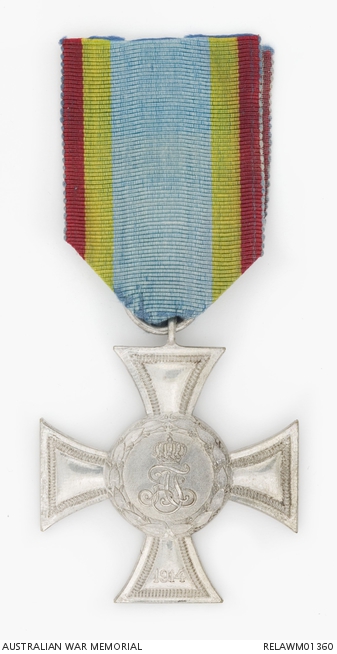| Place | Europe: Germany, Mecklenburg |
|---|---|
| Accession Number | RELAWM01360 |
| Collection type | Heraldry |
| Object type | Award |
| Physical description | Silver |
| Maker |
Unknown |
| Place made | Germany |
| Date made | c 1914 |
| Conflict |
First World War, 1914-1918 |
Mecklenburg-Strelitz Cross for Distinction in War, Second Class

Mecklenburg-Strelitz Cross for Distinction in War, Second Class. Unnamed as issued. A silver cross pattée with a beaded edge line to the arms. Obverse: In the centre a crown over 'FA' surrounded by a laurel wreath and '1914' on the lower arm. Reverse: The inscription 'TAPFER UND TREU' (Brave and Loyal) on three lines within a laurel wreath in the centre. The cross is fitted with a loose ring suspender and a piece of 32 mm pale blue ribbon which has 3 mm side stripes of yellow (inner) and red (outer).
The Cross for Distinction in War was established by Grand Duke Friedrich Wilhelm on 10 March 1871. It was awarded without regard to rank for bravery and military merit and was established as a specific wartime award rather than a general military decoration. Awards of this version were made only for the Franco-Prussian War. A total of 269 were awarded with the inscription 'Tapfer und Treu' (Brave and Loyal) and 14 with the inscription 'Für Tapferkeit' (For Bravery). Apart for one for the Grand Duke, all of the latter went to officers, none below the rank of Major. The decoration was renewed by Grand Duke Adolf Friedrich VI on 11 August 1914 and the date '1914' was added to the lower cross arm. During the First World War through to 31 May 1924, when retroactive awards ceased, a reported 8,131 crosses were awarded with the inscription 'Tapfer und Treu' and 25 with the inscription 'Für Tapferkeit' . All of the latter were to members of the Duke's family or very senior officers (the lowest ranking recipient was the then Generalleutnant Erich Ludendorff). The cross could also be awarded on a non-combatant's ribbon, usually referred to as the 'red ribbon' (as the colors of the combatant's ribbon were reversed, with red predominating). This medal forms part of a collection assembled by the Memorial in the 1920s for display.